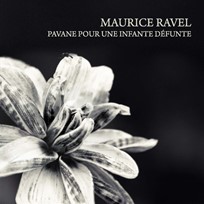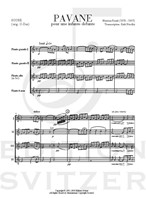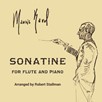
Pavane
Composer: Maurice Ravel
Instrument: Flute Quartet
Level: Advanced
Published: 2009
Price: €22.00
Item details
-
Description +
-
Transcription: Erik Norby
Duration: 6 min.
On the occasion of the Kuhlau Quartet´s 10th anniversary in 1983, the Danich composer Erik Norby orchestrated Maurice Ravels´s famous “Pavane” for flute quartet (two C-flutes, alto flute and a bass flute.) Because of Erik Norby’s great orchestration ability and vivid perception for Ravel´s music, this seemingly impossible task was brilliant solved by him in 1985. In its new form the “Pavane” became a success both as far as the audience and music critics were concerned.
-
-
Instrumentation +
-
Flute Quartet
-
-
About the composer +
-
Joseph Maurice Ravel (7 March 1875 – 28 December 1937) was a French composer, pianist and conductor. He is often associated with impressionism along with his elder contemporary Claude Debussy, although both composers rejected the term. In the 1920s and '30s Ravel was internationally regarded as France's greatest living composer.
Born to a music-loving family, Ravel attended France's premier music college, the Paris Conservatoire; he was not well regarded by its conservative establishment, whose biased treatment of him caused a scandal. After leaving the conservatoire Ravel found his own way as a composer, developing a style of great clarity, incorporating elements of baroque, neoclassicism and, in his later works, jazz. He liked to experiment with musical form, as in his best-known work, Boléro (1928), in which repetition takes the place of development. He made some orchestral arrangements of other composers' music, of which his 1922 version of Mussorgsky's Pictures at an Exhibition is the best known.
As a slow and painstaking worker, Ravel composed fewer pieces than many of his contemporaries. Among his works to enter the repertoire are pieces for piano, chamber music, two piano concertos, ballet music, two operas, and eight song cycles; he wrote no symphonies or religious works. Many of his works exist in two versions: a first, piano score and a later orchestration. Some of his piano music, such as Gaspard de la nuit (1908), is exceptionally difficult to play, and his complex orchestral works such as Daphnis et Chloé (1912) require skilful balance in performance.
Ravel was among the first composers to recognise the potential of recording to bring their music to a wider public. From the 1920s, despite limited technique as a pianist or conductor, he took part in recordings of several of his works; others were made under his supervision.
-
-
Credits +
-
Photo: Sara Josefine Jönsson
Front cover graphics and layout: Ronni Kot Wenzell
Transcription: Erik Norby
Engraving: Johan Svitzer
Printed in Copenhagen, Denmark
Copyright © Edition Svitzer
www.editionsvitzer.com
-




